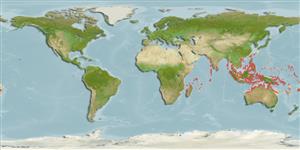>
Eupercaria/misc (Various families in series Eupercaria) >
Scaridae (Parrotfishes) > Scarinae
Etymology: Scarus: Greek, skaros = a fish described by anciente writers as a parrot fish; 1601 (Ref. 45335).
More on author: Valenciennes.
Environment: milieu / climate zone / depth range / distribution range
Ökologie
seewasser riff-verbunden; tiefenbereich 2 - 18 m (Ref. 9710). Tropical; 30°N - 24°S
Indo-West Pacific: India to Vanuatu, north to the Ryukyu Islands, south to New Caledonia; Palau (Belau) in Micronesia.
Size / Gewicht / Alter
Maturity: Lm ? range ? - ? cm
Max length : 40.0 cm TL Männchen/unbestimmt; (Ref. 48636)
Rückenflossenstacheln (insgesamt): 9; Rückenflossenweichstrahlen (insgesamt): 10; Afterflossenstacheln 3; Afterflossenweichstrahlen: 9. This species is distinguished by the following features: 6 median predorsal scales; 3 scale rows on cheek 1(5), 2(5-6), 3(2); lips largely covering the dental plates; caudal fin is truncate to slightly rounded. Colour overall is green to purplish or bluish, sometimes a pink patch on pectoral region, often with lime-green saddle on upper caudal-fin base, a dark green 'moustache' and pale green patch on cheek (Ref. 90102).
Inhabits coral-rich areas of outer channels and seaward reefs (Ref. 9710). Occurs singly or in small groups (Ref. 9710) over intertidal flats to graze on algae during high water mark (Ref. 48636).
Life cycle and mating behavior
Geschlechtsreife | Fortpflanzung | Ablaichen | Eier | Fecundity | Larven
Oviparous, distinct pairing during breeding (Ref. 205).
Myers, R.F., 1991. Micronesian reef fishes. Second Ed. Coral Graphics, Barrigada, Guam. 298 p. (Ref. 1602)
IUCN Rote Liste Status (Ref. 130435)
Bedrohung für Menschen
Harmless
Nutzung durch Menschen
Fischereien: kommerziell
Mehr Information
ReferenzenAquakulturAquakultur ProfilZuchtlinienGenetikElectrophoresesVererbbarkeitKrankheitenVerarbeitungNutrientsMass conversion
PartnerBilderStamps, Coins Misc.LauteCiguateraGeschwindigkeitSchwimmstilKiemenoberflächeOtolithsGehirngrößeSehfähigkeit
Tools
Zusatzinformationen
Download XML
Internet Quellen
Estimates based on models
Preferred temperature (Ref.
123201): 26 - 29.3, mean 28.6 °C (based on 2738 cells).
Phylogenetic diversity index (Ref.
82804): PD
50 = 0.5000 [Uniqueness, from 0.5 = low to 2.0 = high].
Bayesian length-weight: a=0.01660 (0.00936 - 0.02944), b=3.12 (2.96 - 3.28), in cm total length, based on LWR estimates for this species & Genus-body shape (Ref.
93245).
Trophic level (Ref.
69278): 2.0 ±0.0 se; based on diet studies.
Widerstandsfähigkeit (Ref.
120179): hoch, Verdopplung der Population dauert weniger als 15 Monate. (Preliminary K or Fecundity.).
Fishing Vulnerability (Ref.
59153): Low to moderate vulnerability (30 of 100).
Nutrients (Ref.
124155): Calcium = 46.3 [25.6, 79.3] mg/100g; Iron = 0.711 [0.456, 1.202] mg/100g; Protein = 18.1 [16.0, 20.0] %; Omega3 = 0.0533 [, ] g/100g; Selenium = 19.6 [10.2, 36.2] μg/100g; VitaminA = 48.1 [11.9, 186.6] μg/100g; Zinc = 2.31 [1.65, 3.16] mg/100g (wet weight);
